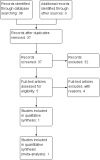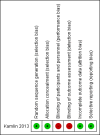Orotracheal intubation in infants performed with a stylet versus without a stylet
- PMID: 28640930
- PMCID: PMC6481391
- DOI: 10.1002/14651858.CD011791.pub2
Orotracheal intubation in infants performed with a stylet versus without a stylet
Abstract
Background: Neonatal endotracheal intubation is a common and potentially life-saving intervention. It is a mandatory skill for neonatal trainees, but one that is difficult to master and maintain. Intubation opportunities for trainees are decreasing and success rates are subsequently falling. Use of a stylet may aid intubation and improve success. However, the potential for associated harm must be considered.
Objectives: To compare the benefits and harms of neonatal orotracheal intubation with a stylet versus neonatal orotracheal intubation without a stylet.
Search methods: We searched the Cochrane Central Register of Controlled Trials (CENTRAL) in the Cochrane Library; MEDLINE; Embase; the Cumulative Index to Nursing and Allied Health Literature (CINAHL), and previous reviews. We also searched cross-references, contacted expert informants, handsearched journals, and looked at conference proceedings. We searched clinical trials registries for current and recently completed trials. We conducted our most recent search in April 2017.
Selection criteria: All randomised, quasi-randomised, and cluster-randomised controlled trials comparing use versus non-use of a stylet in neonatal orotracheal intubation.
Data collection and analysis: Two review authors independently assessed results of searches against predetermined criteria for inclusion, assessed risk of bias, and extracted data. We used the standard methods of the Cochrane Collaboration, as documented in the Cochrane Handbook for Systemic Reviews of Interventions, and of the Cochrane Neonatal Review Group.
Main results: We included a single-centre non-blinded randomised controlled trial that reported a total of 302 intubation attempts in 232 infants. The median gestational age of enrolled infants was 29 weeks. Paediatric residents and fellows performed the intubations. We judged the study to be at low risk of bias overall. Investigators compared success rates of first-attempt intubation with and without use of a stylet and reported success rates as similar between stylet and no-stylet groups (57% and 53%) (P = 0.47). Success rates did not differ between groups in subgroup analyses by provider level of training and infant weight. Results showed no differences in secondary review outcomes, including duration of intubation, number of attempts, participant instability during the procedure, and local airway trauma. Only 25% of all intubations took less than 30 seconds to perform. Study authors did not report neonatal morbidity nor mortality. We considered the quality of evidence as low on GRADE analysis, given that we identified only one unblinded study.
Authors' conclusions: Current available evidence suggests that use of a stylet during neonatal orotracheal intubation does not significantly improve the success rate among paediatric trainees. However, only one brand of stylet and one brand of endotracheal tube have been tested, and researchers performed all intubations on infants in a hospital setting. Therefore, our results cannot be generalised beyond these limitations.
Conflict of interest statement
Joyce O'Shea: nothing to declare. Jennifer O'Gorman: nothing to declare. Aakriti Gupta: nothing to declare. Sanjay Sinhal: nothing to declare. Jann Foster: nothing to declare. Liam O'Connell: co‐investigator on a trial that was eligible for inclusion in this review. Camille Omar Farouk Kamlin: co‐investigator on a trial that was eligible for inclusion in this review. Peter Davis: co‐investigator on a trial that was eligible for inclusion in this review.
Figures








Update of
- doi: 10.1002/14651858.CD011791
References
References to studies included in this review
References to studies excluded from this review
Fisher 1997 {published data only}
-
- Fisher QA, Tunkel DE. Lightwand intubation of infants and children. Journal of Clinical Anaesthesia 1997;9(4):275‐9. [PUBMED: 9195348] - PubMed
MacNab 1998 {published data only}
-
- MacNab AJ, MacPhail I, MacNab MK, Noble R, O'Flaherty D. A comparison of intubation success for paediatric transport team paramedics using lighted vs regular tracheal tube stylets. Paediatric Anaesthesia 1998;8(3):215‐20. [PUBMED: 9608966] - PubMed
Shukry 2005 {published data only}
Yamashita 2015 {published data only}
-
- Yamashita S, Takahashi S, Osaka Y, Fujikura K, Tabata K, Tanaka M. Efficacy of the transillumination method for appropriate tracheal tube placement in small children: a randomized controlled trial. Journal of Clinical Anesthesia 2015;27(1):12‐6. [doi: 10.1016/j.jclinane.2014.09.003; PUBMED: 25457173] - PubMed
Additional references
AAP 2016
-
- American Academy of Pediatrics, American Heart Association. Textbook of Neonatal Resuscitation (NRP). 7th Edition. Elk Grove Village, IL: American Academy of Pediatrics, 2016.
Aziz 1999
-
- Aziz HF, Martin JB, Moore JJ. The pediatric disposable end‐tidal carbon dioxide detector role in endotracheal intubation in newborns. Journal of Perinatology 1999;19(2):110‐3. [PUBMED: 10642970] - PubMed
Bhargava 1998
-
- Bhargava M, Pothula SN, Joshi S. The obstruction of an endotracheal tube by the plastic coating sheared from a stylet: a revisit. Anesthesiology 1998;88(2):548‐9. [PUBMED: 9477085] - PubMed
Boyd 1999
Carbajal 2007
Chiou 2007
Cook 1985
-
- Cook WP, Schultetus RR. Obstruction of an endotracheal tube by the plastic coating sheared from a stylet. Anesthesiology 1985;62(6):803‐4. [PUBMED: 4003804] - PubMed
Cook‐Sathler 1998
-
- Cook‐Sather SD, Tulloch HV, Cnaan A, Nicolson SC, Cubina ML, Gallagher PR, et al. A comparison of awake versus paralysed tracheal intubation for infants with pyloric stenosis. Anesthesia and Analgesia 1998;86(5):945–51. [PUBMED: 9585274] - PubMed
Deeks 2011
-
- Deeks JJ, Higgins JPT, Altman DG. Chapter 9: Analysing data and undertaking meta‐analysis. In: Higgins JPT, Green S (editors). Cochrane Handbook for Systematic Reviews of Interventions Version 5.1.0 [updated March 2011]. The Cochrane Collaboration, 2011. www.cochrane‐handbook.org.
Dempsey 2006
-
- Dempsey EM, Al Hazzani F, Faucher D, Barrington KJ. Facilitation of neonatal endotracheal intubation with mivacurium and fentanyl in the neonatal intensive care unit. Archives of Disease in Childhood. Fetal and Neonatal Edition 2006;91(4):F279‐82. [DOI: 10.1136/adc.2005.087213; PUBMED: 16464937] - DOI - PMC - PubMed
Falck 2003
-
- Falck AJ, Escobedo MB, Baillargeon JG, Villard LG, Gunkel JH. Proficiency of pediatric residents performing neonatal endotracheal intubation. Pediatrics 2003;112(6 Pt 1):1242‐7. [PUBMED: 14654592] - PubMed
Finan 2012
Ghanta 2007
-
- Ghanta S, Abdel‐Latif ME, Lui K, Ravindranathan H, Awad J, Oei J. Propofol compared with the morphine, atropine, and suxamethonium regimen as induction agents for neonatal endotracheal intubation: a randomized, controlled trial. Pediatrics 2007;119(6):E1248‐55. [DOI: 10.1542/peds.2006-2708; PUBMED: 17485450] - DOI - PubMed
GRADEpro GDT [Computer program]
-
- GRADE Working Group, McMaster University. GRADEpro GDT. Version (accessed 9 April 2016). Hamilton, ON: GRADE Working Group, McMaster University, 2014.
Greenland 1985
-
- Greenland S, Robins JM. Estimation of a common effect parameter from sparse follow‐up data. Biometrics 1985;41(1):55‐68. [PUBMED: 4005387] - PubMed
Guyatt 2008
Haubner 2013
Higgins 2003
Higgins 2011a
-
- Higgins JPT, Deeks JJ (editors). Chapter 7: Selecting studies and collecting data. In: Higgins JPT, Green S, editor(s). Cochrane Handbook for Systematic Reviews of Interventions Version 5.1.0 [updated March 2011]. The Cochrane Collaboration, 2011. handbook.cochrane.org.
Higgins 2011b
-
- Higgins JPT, Altman DG, Sterne JAC (editors). Chapter 8: Assessing risk of bias in included studies. In: Higgins JPT, Green S, editor(s). Cochrane Handbook for Systematic Reviews of Interventions Version 5.1.0 [updated March 2011]. The Cochrane Collaboration, 2011. www.cochrane‐handbook.org.
ILCOR 2005
-
- International Liaison Committee on Resuscitation. 2005 International consensus on cardiopulmonary resuscitation and emergency cardiovascular care science with treatment recommendations. Part 7: neonatal resuscitation.. Resuscitation 2005;67(2‐3):293‐303. [DOI: 10.1016/j.resuscitation.2005.09.014; PUBMED: 16324993] - DOI - PubMed
Kattwinkel 2006
-
- Kattwinkel J, Short J, Shavell L, Siede B. Textbook of Neonatal Resuscitation. 5th Edition. Elk Grove, IL: American Academy of Pediatrics, 2006.
Lane 2004
Lemyre 2009
Leone 2005
Mantel 1959
-
- Mantel N, Haenszel W. Statistical aspects of the analysis of data from retrospective studies of disease. Journal of the National Cancer Institute 1959;22(4):719‐48. [PUBMED: 13655060] - PubMed
Marshall 1984
-
- Marshall TA, Deeder R, Pai S, Berkowitz GP, Austin TL. Physiologic changes associated with endotracheal intubation in preterm infants. Critical Care Medicine 1984;12(6):501–3. [PUBMED: 6723333] - PubMed
McAuliffe 1995
Meneghini 2000
-
- Meneghini L, Zadra N, Metrangolo S, Narne S, Giusti F. Post‐intubation subglottal stenosis in children: risk factors and prevention in pediatric intensive care. Minerva Anestesiologica 2000;66(6):467‐71. [PUBMED: 10961059] - PubMed
Nishiasaki 2010
O'Donnell 2006
Perlman 2010
-
- Perlman JM, Wyllie J, Kattwinkel J, Atkins DL, Chameides L, Guinsburg R, et al. Part 11: Neonatal resuscitation: 2010 International consensus on cardiopulmonary resuscitation and emergency cardiovascular care science with treatment recommendations. Circulation 2010;122(16 Suppl 2):S516‐38. [DOI: 10.1161/CIRCULATIONAHA.110.971127; PUBMED: 20956259] - DOI - PubMed
Rabb 1998
-
- Rabb MF, Larson SM, Greger JR. An unusual cause of partial ETT obstruction. Anesthesiology 1998;88(2):548. [PUBMED: 9477084] - PubMed
Repetto 2001
RevMan 2014 [Computer program]
-
- The Cochrane Collaboration. Review Manager 5 (RevMan 5). Version 5.3. Copenhagen: Nordic Cochrane Centre, The Cochrane Collaboration, 2014.
Richmond 2011
-
- Richmond S, Wyllie J. Newborn Life Support. 3rd Edition. London, UK: Resuscitation Council, 2011.
Roberts 1995
-
- Roberts WA, Maniscalco WM, Cohen AR, Litman RS, Chhibber A. The use of capnography for recognition of esophageal intubation in the neonatal intensive care unit. Pediatric Pulmonology 1995;19(5):262‐8. [PUBMED: 7567200] - PubMed
Roberts 2006
-
- Roberts KD, Leone TA, Edwards WH, Rich WD, Finer NN. Premedication for nonemergent neonatal intubations: a randomized, controlled trial comparing atropine and fentanyl to atropine, fentanyl, and mivacurium. Pediatrics 2006;118(4):1583‐91. [DOI: 10.1542/peds.2006-0590; PUBMED: 17015550] - DOI - PubMed
Schünemann 2013
-
- Schünemann H, Brożek J, Guyatt G, Oxman A, editors. GRADE Working Group. GRADE Handbook for Grading Quality of Evidence and Strength of Recommendations. https://gdt.gradepro.org/app/handbook/handbook.html [Updated October 2013].
Silva 2007
Wei 2011
Zmyslowski 1989
-
- Zmyslowski WP, Kam D, Simpson GT. An unusual cause of endotracheal tube obstruction. Anesthesiology 1989;70(5):883. [PUBMED: 2719333] - PubMed
Publication types
MeSH terms
LinkOut - more resources
Full Text Sources
Other Literature Sources
Miscellaneous

